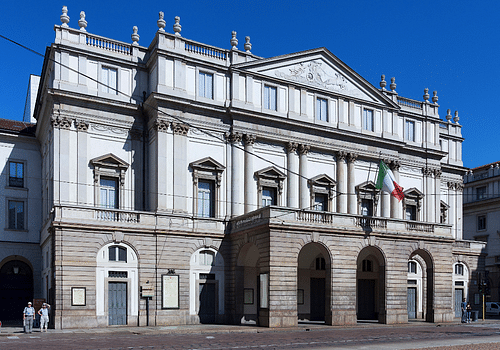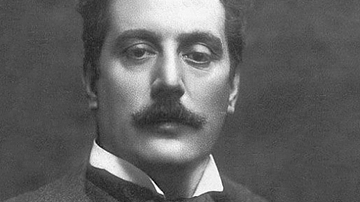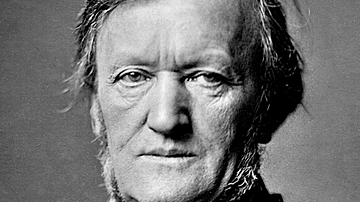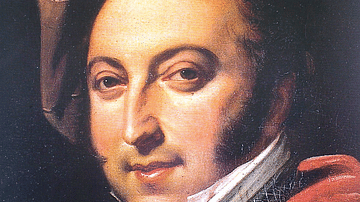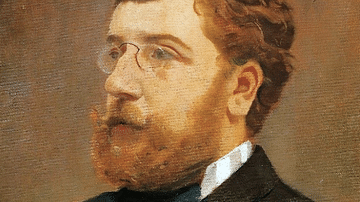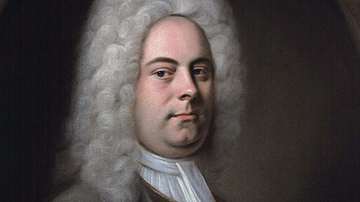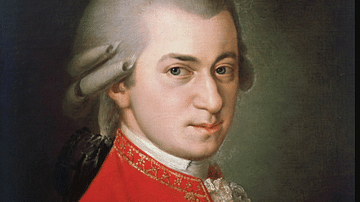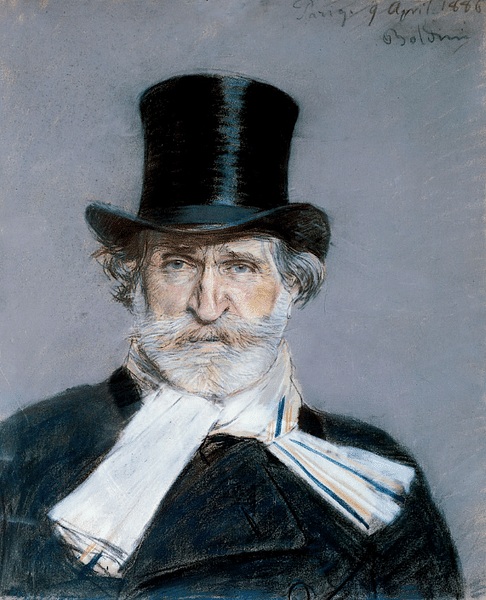
Giuseppe Verdi (1813-1901) was an Italian composer best known for operas such as Rigoletto, La traviata, and Aida. Verdi is noted for his powerful scores and strong characters where anti-heroes lead the dramatic action through often complex plots. Verdi was hugely successful across Europe in his own lifetime, but he did occasionally stray from opera, most notably with his 1874 Requiem.
Early Life
Giuseppe Verdi was born in La Roncola (Le Roncole), a small town near Parma in the centre of northern Italy on 10 October 1813. La Roncola, part of the Duchy of Parma, was then controlled by the French and, from 1815, Austria. His parents owned an osteria, a simple eating place. He played piano from the age of three with the help of the local church organist, and when he was just ten years old he was already good enough to stand in when the organist was away. At the same time, he studied music in Busseto near Parma.
Verdi was awarded a scholarship by a local charity when he was 18 and so went to Milan, but he was rejected by the Conservatory there. The rejection was likely not based on his skills or lack of them but his unconventional method of acquiring them, the fact that he was a little older than a normal first-year student and that technically Verdi was classed as a foreigner in Milan since the state of Parma was nothing to do with Lombardy.
Still, Verdi had been taken into the care of Antonio Barezzi, a wealthy Busseto merchant who loved music and who was the president of the Busseto Philharmonic Society. Barezzi decided to help by paying for Giuseppe's private tuition in Milan. This private musical education included lessons with Vincenzo Lavigna, the conductor of Milan's foremost theatre, La Scala. Another important source of music education was the many theatre performances in Milan which Verdi frequently attended. Verdi's next paid position was in 1834 as musical director back in Busseto, which included being the cathedral's organist. This job went awry before it even began as Verdi hesitated to leave Milan, and a row ensued over just who was the new musical director in Busseto. In his personal life, Verdi repaid Barezzi's faith in him by marrying his daughter Margherita in 1836. The couple went on to have two children, but both died in early infancy. When Antonio Barezzi died many years later, Verdi said, "I owe him absolutely everything" (Steen, 519).
Verdi began work on his first opera, Rocester, but it was rejected by the Parma Opera House. The composer may have reused some parts for his next attempt, Oberto. This work was to be staged by the La Scala theatre in Milan in November 1839, and so Verdi (and his family) moved to the city for a second time. The success of the premiere of Verdi's first opera and a contract with both La Scala and the publisher Giovanni Records were overshadowed by two tragic deaths, first of his son, and then, in June 1840, his wife died of encephalitis (inflammation of the brain).

The bad times kept on coming when, in September 1840, Verdi's second opera, Un giorno di regno ('King for a Day'), which was also staged at La Scala, was a total flop that only managed a single performance before it was dropped. Verdi was a little mystified why this had happened; a lack of rehearsal time seems to have been the real cause. Verdi himself once wrote: "It may be that it is a bad opera, though many no better are tolerated and even applauded…I do not mean to blame the public, but I accept their criticisms and jeers only on condition that I do not have to be grateful for their applause." (Schonberg, 275-6) Verdi's character – withdrawn, proud, testy, and even tyrannical with those closest to him – at least protected him from the professional critics who never really warmed to him until his final decade.
Nabucco: The First Hit
In his earlier works, Verdi was influenced by the operas of fellow-Italian composer Gaetano Donizetti (1797-1848). He was also influenced by the bel canto tradition, that is, the light and melodic singing style popular in Italian opera. Another influence was Gioachino Rossini (1792-1868), famed for such comic operas as L'italiana in Algeri ('The Italian Girl in Algiers') and Il barbiere di Siviglia ('The Barber of Seville'), which were first staged in 1813 and 1816, respectively. Rossini had innovated with the use of an expanded chorus, orchestral music, the embellishment of arias, and a strong focus on characterisation. One composer that Verdi was not influenced by was the other great contemporary opera man, Richard Wagner (1813-1883). These two giants of the genre largely ignored each other throughout their long and highly successful careers. There was a gulf between the big symphonic-like works of Wagner and the intimate melodramas of Verdi as wide as the Alps that separated the composers geographically.
Verdi's next opera, Nabucco was inspired by the Babylonian king Nebuchadnezzar II (r. c. 605-562 BCE) who appears in the Bible (books Daniel and Jeremiah) where he stands against God. In Italian, the king's name is Nabucodonosor, and so the opera's title is an abbreviation. It shows Rossini's influence with a bulked-up chorus and memorable characters. The music recalls Donizetti and Rossini, but there is something more, a new, fresh sound and a much faster pace of storytelling using words and music than seen in any previous opera. Such was the effect of this novelty, "it was impossible to work offstage while the rehearsals were going on, for employees, workmen, painters, machinists, excited by the music they were hearing, left their tasks to stand open-mouthed and watch what was taking place on stage", noted one eyewitness (Schonberg, 276). Nabucco, first staged in March 1842 at La Scala, was a great success, and audiences ever since have been particularly impressed with the "Va, pensiero" chorus of the Hebrew slaves. Nabucco was staged across Europe and as far afield as New York, Constantinople, and Buenos Aires; in short, opera number four made Verdi both rich and famous.
Always in demand, the composer rattled off a whole series of operas which were performed across Italy. He largely stuck to the winning formula of Nabucco in that many of the operas were based on historical figures or events and the main protagonist was usually not an outright hero. Verdi often wrote the text and then employed a librettist to put that into verse, the librettist being very closely supervised. He also increased the role of the orchestra and insisted his singers could act well. Through the 1840s, Verdi worked so incessantly, he later referred to the period when he churned out two operas each year as his "galley years".
Verdi gained critical support for his work from such important figures as Franz Liszt (1811-1886). Many of Verdi's operas were based on the works of noted literary figures, notably Lord Byron (for I due pescatori or 'The Two Fishermen'), Friedrich Schiller (for Giovanna d'Arco or 'Joan of Arc'), and Voltaire (for Alzira). In his Macbeth opera of 1847, Verdi turned to William Shakespeare. The combination was a success; the public loved the premiere of Macbeth so much, Verdi was obliged to make an astonishing 38 curtain calls.
By 1847, Verdi's work had caught the attention of foreign theatre directors, and his I masnadieri ('The Brigands') was staged in London's Her Majesty's Theatre in June of that year. Queen Victoria (r. 1837-1901) attended the premiere.
It was also in 1847 that Verdi began a love affair with Giuseppina Strepponi (1815-1897). Giuseppina was a soprano singer, indeed she had starred in Verdi's Nabucco. In 1848, Verdi's success enabled him to buy a house with a large farm at Sant' Agata near his hometown where he enjoyed shooting and gardening. Here he lived unmarried with Giuseppina, much to the distress of local gossips. The couple eventually married on 29 August 1859 in Collonges-sur-Salève on the Franco-Swiss border; they never had children but did adopt a child of a cousin of Verdi's.
Mature Style
From around 1849, Verdi began to write operas which were not so related to historical events. As Verdi himself once noted, "It may be a good thing to copy reality; but to invent reality is much, much better" (Wade-Mathews, 408). In March 1851, Rigoletto (originally called La Maledizione or 'The Curse') was another success. The story concerns the title character, a hunchback jester whose daughter is seduced and so he attempts revenge but only brings about her death. The story was based on the play Le roi s'amuse by Victor Hugo (1802-1885), which was highly controversial because it involved a rape scene. The idea of a tragic ending would be repeated in Il trovatore ('The Troubadour') and La traviata ('The Fallen Woman'), both of which were first staged in January 1853. The latter opera is based on La dame aux camélias written by Alexandre Dumas fils (which was itself based on real-life events) where the central character is a courtesan who sacrifices her own happiness to safeguard the honour of the man she loves. Initially, La traviata was not a success but Verdi tweaked various parts – a habit he applied to many of his operas over the years – and it became a resounding success.
The Encyclopedia of Music describes Verdi's mature work as possessing "a new operatic realism and intensity of expression" (324). He often wrote with a specific singer in mind, and it is noteworthy that baritone singers often receive the most striking arias and duets. But all the solo singers in a Verdi opera must act convincingly and sing in such a way that represents the emotional turmoil of the character they are playing. Critics have said that Verdi overdid the emotion and neglected any possible sophistication in his librettos, but he knew what the public wanted and was willing to deliver time and again. Verdi also knew that an audience remembers much better a tune than it does the words. Verdi played on big emotions – the composer Georges Bizet (1838-1875) once said of Verdi, "His passion is brutal, true" (Schonberg, 282) – and he was not too subtle in presentation. If he had been a painter, he would surely have been a Vincent Van Gogh rather than a Canaletto. Critics harped at the lack of sophisticated orchestration and the simplistic language of the librettos. It seemed that the more popular Verdi became with the public, the more the music critics attacked. Even when they acknowledged Verdi's popularity, the critics smugly reminded their readers that this sort of music was but a fad and would soon disappear. How wrong they were.
The Grand Operas
From the mid-1850s, and assured of his position as a great composer of opera, Verdi began to create ever-grander productions. These grand operas had four or five acts and an enlarged cast and chorus. Paris staged Les vêpres siciliennes ('The Sicilian Vespers') in 1855, Simon Boccanegra opened in Venice in 1857, and La forza del destino ('The Force of Destiny') was premiered in St. Petersburg in 1862. Other grand operas of this period include Don Carlos, premiered in Paris in 1867, and Aida, premiered in Cairo on Christmas Eve 1871. Perhaps for relief, there was the shorter three-act opera Un ballo in maschera ('A Masked Ball') in 1859.
Aida was commissioned in 1870 for the opening of the Cairo Opera House and has become the example par excellence of Verdi's grand-scale operas. The story takes place in ancient Egypt and tells of a captured Ethiopian princess who enchants an Egyptian general only for it all to end in tragedy. The plot location demands exotic and monumental sets, much to the delight of ambitious stage designers ever since. The Franco-Prussian War caused havoc in Europe and meant the costumes could not be shipped to Cairo until the end of 1871 when Aida finally had its debut (Rigoletto had been put on the year before to inaugurate the opera house). Aida received its European premiere at La Scala in February 1872.
The Risorgimento
Some – especially censors – saw strong hints of Italian nationalism in Verdi's work in a period when there was a growing movement, for the first time, to unite the various Italian states into a single country, the Risorgimento. The "Va pensiero" chorus and the lament of the Scottish exiles in Macbeth seemed to echo the calls for an improvement in the lives of ordinary citizens. Verdi's 1849 opera La battaglia di Legnano ('The Battle of Legnano') was an even more explicit political statement that Italians wanted to rule themselves, albeit using as a mirror to current events the historical battle of the 12th century between the Lombard League (the victors) and the Holy Roman Empire. From 1859 and Simon Boccanegra's triumphant Italian premiere in Rome, audiences began to shout out "Viva Verdi!" during the applause. The term had a double meaning since it was also a code for royalists and supporters of Victor Emmanuel II, the first king of a united Italy (r. 1861-1878), "Verdi" being an acrostic for Viva Vittorio Emanuel Re D'Italia ('Long Live Victor Emanuel, king of Italy').
Verdi's interest in active politics is ambiguous. He was appointed to a local assembly in Parma before, in 1861, he was elected a member of the new Italian parliament in Turin as representative for Busseto. Verdi may have been cornered into this role by the wily prime minister Count Camillo di Cavour (1810-1861), but he at least attended parliament diligently and even proposed a bill to increase funding for music. Verdi held the position of MP for four years.
Verdi's patriotism was more clearly in evidence when he wrote his Requiem to commemorate the death of Alessandro Manzoni (1785-1873), the great Italian poet whose work had also promoted the national cause of unification. The Requiem has been described as an opera in disguise, and it was very popular on its first performance in a memorial service for Manzoni in Milan's San Marco Church on 22 May 1874 and at subsequent performances across Europe. Johannes Brahms (1833-1897) said of the Requiem, "Only a genius could have written such a work" (Steen, 540).
Last Works
Verdi kept on working into his seventies. Non-operatic work included his Quattro pezzi sacri ('Four Sacred Pieces'), published in 1898. Many critics consider his last two operas, Otello (1887), based on Shakespeare's Othello, and Falstaff (1893), based on the same playwright's The Merry Wives of Windsor, as his finest work. Verdi created both of these operas with the gifted composer-librettist Arrigo Boito (1842-1918). Both were rapturously premiered at La Scala. Boito described the public adulation outside the famous theatre: "insane, the crowd tried to shoulder Verdi's carriage and carry it from La Scala to the Grand Hotel up the street" (Steen, 542).
The pair of operas are the summit of Verdi's career where he combines music and words with a masterful command of the orchestra. The music historian C. Schonberg describes Falstaff as "subtle, fast-moving, full of glints, mocking laughter, high humor. Falstaff is a commentary on life, a summation of a career, a jest – and such a civilised one! – with its undertone of sadness. Verdi knew it was to be his last opera" (291).
Verdi's Greatest Operas
Giuseppe Verdi wrote 28 operas in total, but his most famous, with their first performance dates indicated in brackets, include:
- Nabucco (1842)
- Giovanna d'Arco (1845)
- Macbeth (1847)
- Luisa Miller (1849)
- Rigoletto (1851)
- Il trovatore (1853)
- La traviata (1853)
- Les vêpres siciliennes (1855)
- Simon Boccanegra (1857)
- Un ballo in maschera (1859)
- La forza del destino (1862)
- Don Carlos (1867)
- Aida (1871)
- Otello (1887)
- Falstaff (1893)
Death & Legacy
Verdi suffered a stroke and one week later died in the Grand Hotel in Milan on 27 January 1901. He left a considerable sum to the home for aged and impoverished musicians which he had founded in Milan, Casa Verdi. Despite all his fame as a composer of operas, Verdi regarded the musicians' home as his "greatest work" (Wade-Matthews, 409). Indeed, Verdi was buried at the home, in the courtyard beside Giuseppina who had predeceased him in November 1897. The simple burial ceremony was accompanied by the attendant crowd spontaneously singing "Va, pensiero".
Verdi's successor as the foremost opera writer was Giacomo Puccini (1858-1924). It was a performance of Verdi's Aida in Pisa that persuaded Puccini to take up the profession. Verdi's house at Sant' Agata, the Villa Sant' Agata, is today kept as a museum, while many of his music-related possessions can be seen in the small museum of La Scala, recognised today as the spiritual home of world opera, a genre of music today, despite all the composers that have come after, unthinkable without the works of Giuseppe Verdi. As Donizetti had once predicted, Verdi occupies "one of the most honored places in the cohort of composers" (Schonberg, 276).
Verdi's major operas have never not been performed, and they continue to enchant audiences worldwide, perhaps none more evocatively than in his native Italy and the annual opera season held in the ancient Roman amphitheatre in Verona where this author has heard more than one enraptured audience member shout above the crescendo of applause, "Viva Verdi!, Viva Verdi!"
